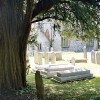During the 18th century Portland was truly an island. Its three thousand acres composed entirely of Jurassic rock assured a bleak existence for the inhabitants: a close-knit, hard-working community with their own ways and customs and, to the chagrin of the authorities at Weymouth, their own interpretation of the laws of salvage.
Gavelkind, a form of land tenure from Anglo-Saxon times, had been supplanted elsewhere in England but here it was still used. With the equal division of land at each generation the inevitable consequence for the social structure was to squeeze out anything like a middle-class and cause a general levelling down which ensured the resulting poverty was equally shared.
An unusual custom on the island concerning matrimonial arrangements almost guaranteed there would be no marriages without issue. On Portland, women selected their mates and entered into marriage only after pregnancy was confirmed. John Smeaton (1724-1792), a civil engineer, tells us in his book published in 1791: Narrative of the Buildings and a Description of the Construction of the Eddystone Lighthouse with Stone how very proud his London born foreman was of the fact that illegitimacy was unheard of and assured his employer: “there was but one child on record that had been born a bastard in the compass of 150 years”. Failure to achieve pregnancy “after a competent time of courtship” meant “that they are not destined by Providence for each other” and the woman was “free to seek another suitor as if she had been left a widow or that nothing had happened”. A cursory glance through the baptism register confirms this claim.
It was in the 17th century that the export of fine building stone got under way but according to John Smeaton it was “shipped in the rough…to be sawn and fair wrought to the particular purpose where wanted”. Stone quarrying brought only unskilled lowly paid work for the Portland men, a situation further aggravated as spoil heaps of rock and sub-soil littered the island reducing the already limited areas available for growing crops and produce. Skilled stone masons came to the island after 1739.
The islanders had little contact with the rest of the country other than with the villagers of Wyke Regis from whom they would buy supplies, share fishing grounds and unite to thwart the Weymouth Custom Officers in matters of wrecking and salvage, an activity we will look at in greater detail in another article.
Access to the island was by a rope-drawn ferry boat, by all accounts a hazardous journey. The island was first joined to the mainland in 1839 by a toll bridge over the Fleet to Wyke Regis and Weymouth and by the railway in 1865. The present causeway was opened in 1985.



